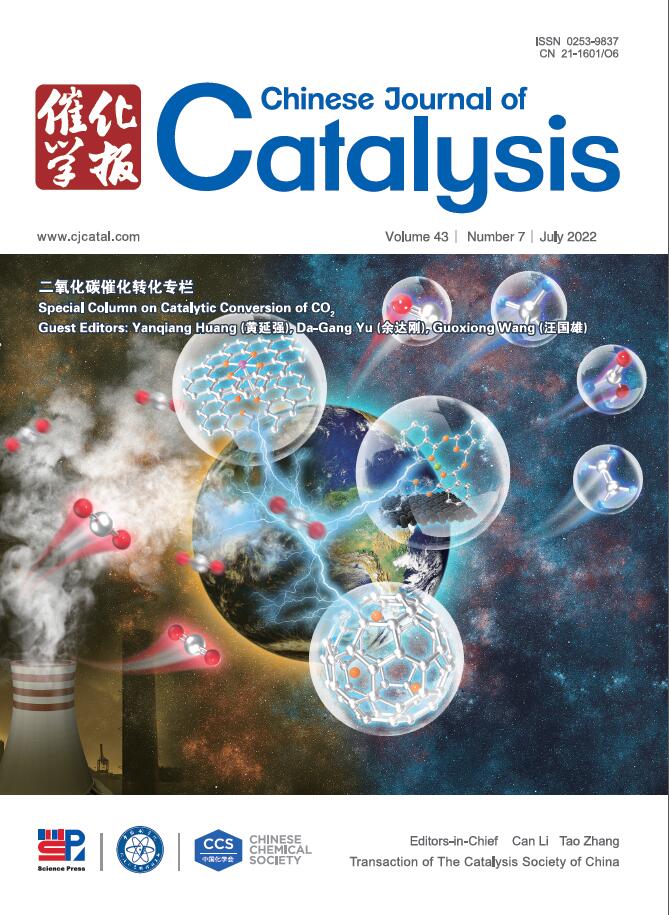A de novo biomimetic enzyme-nanozyme hybrid system for advancing lignin valorization
IF 15.7
1区 化学
Q1 CHEMISTRY, APPLIED
引用次数: 0
Abstract
Directed degradation of abundant renewable lignin into small aromatic compounds is crucial for lignin valorization but challenging. The degradation of lignin in natural environments typically involves multienzyme synergy. However, the proteinaceous characteristics of lignin-degrading enzymes restrict their accessibility to certain regions of intricate lignin, resulting in the multienzyme systems being unable to fully demonstrate their effectiveness. Herein, a de novo biomimetic enzyme-nanozyme hybrid system was constructed by combining λ-MnO2 nanozyme with laccase CotA from Bacillus subtilis, aimed at facilitating lignin degradation under mild conditions. The lignin degradation rate of the CotA + λ-MnO2 hybrid system was determined to be 25.15%, which was much higher than those of the lignin degradation systems with only laccase CotA (15.32%) or λ-MnO2 nanozyme (14.90%). Notably, the proportion of aromatic chemicals in the products derived from the hybrid system reached as much as 48%, which was 41.2% and 118.2% higher than those of the CotA- and λ-MnO2-catalyzed systems, respectively. Analysis of products mapping and lignin structure changes suggested that the higher proportion of aromatic compounds in the CotA + λ-MnO₂ hybrid system was more likely to benefit from the laccase-mediated methoxylation. Moreover, electron paramagnetic resonance analysis indicated that the intensity and kind of free radicals such as •OH and •O2– are closely linked to the degradation rate and reaction type. This work is the inaugural application of an enzyme-nanozyme hybrid system for lignin degradation, demonstrating the potential of the synergistic interaction between enzyme and nanozyme in the directed degradation of lignin.
促进木质素增值的全新仿生酶-纳米酶杂交系统
将丰富的可再生木质素定向降解为小的芳香族化合物是木质素增值的关键,但具有挑战性。木质素在自然环境中的降解通常涉及多酶协同作用。然而,木质素降解酶的蛋白质特性限制了它们对复杂木质素的某些区域的可及性,导致多酶系统无法充分展示其有效性。本文以枯草芽孢杆菌中λ-MnO2纳米酶与漆酶CotA结合,构建了一种全新的仿生酶-纳米酶杂交体系,旨在促进温和条件下木质素的降解。结果表明,CotA + λ-MnO2复合体系对木质素的降解率为25.15%,远高于仅使用漆酶CotA(15.32%)或λ-MnO2纳米酶的木质素降解体系(14.90%)。值得注意的是,该杂化体系产物中芳香族化学物质的比例高达48%,分别比CotA-和λ- mno2催化体系高41.2%和118.2%。产物定位和木质素结构变化分析表明,CotA + λ- mno2杂化体系中芳香族化合物比例越高,越有可能受益于漆酶介导的甲氧基化反应。电子顺磁共振分析表明,•OH和•O2 -自由基的强度和种类与降解速率和反应类型密切相关。这项工作是木质素降解酶-纳米酶杂交系统的首次应用,证明了酶和纳米酶之间的协同相互作用在木质素定向降解中的潜力。
本文章由计算机程序翻译,如有差异,请以英文原文为准。
求助全文
约1分钟内获得全文
求助全文
来源期刊

Chinese Journal of Catalysis
工程技术-工程:化工
CiteScore
25.80
自引率
10.30%
发文量
235
审稿时长
1.2 months
期刊介绍:
The journal covers a broad scope, encompassing new trends in catalysis for applications in energy production, environmental protection, and the preparation of materials, petroleum chemicals, and fine chemicals. It explores the scientific foundation for preparing and activating catalysts of commercial interest, emphasizing representative models.The focus includes spectroscopic methods for structural characterization, especially in situ techniques, as well as new theoretical methods with practical impact in catalysis and catalytic reactions.The journal delves into the relationship between homogeneous and heterogeneous catalysis and includes theoretical studies on the structure and reactivity of catalysts.Additionally, contributions on photocatalysis, biocatalysis, surface science, and catalysis-related chemical kinetics are welcomed.
 求助内容:
求助内容: 应助结果提醒方式:
应助结果提醒方式:


